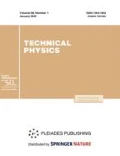Abstract
In the continuum theory of defects the total strain of an inelastic material can be represented by the sum of the reversible elastic strain associated with external loads, the compatible elastoplastic strain due to defects of the material, and the compatible plastic strain responsible for irreversible deformation of the material. The proposed scheme of separation of the strain into distinct components can be used to determine the physical significance of the inelastic properties of materials and the object of description of a gauge model representing a dynamical generalization of the continuum theory of defects.
Similar content being viewed by others
References
A. Kadic and D. G. B. Edelen, A Gauge Theory of Dislocations and Disclinations (Lectures Notes in Physics, Vol. 174) (Springer-Verlag, Heidelberg, 1983), 168 pp.
D. G. B. Edelen and D. C. Lagoudas, A Gauge Theory and Defects in Solids (North-Holland, Amsterdam, 1988), 189 pp.
D. G. B. Edelen and D. C. Lagoudas, Int. J. Eng. Sci. 26, 837 (1988).
Yu. V. Grinyaev and N. V. Chertova, Izv. Vyssh. Uchebn. Zaved. Fiz. No. 2, 34 (1990).
V. L. Popov and N. V. Chertova, Izv. Vyssh. Uchebn. Zaved. Fiz. No. 4, 81 (1992).
N. V. Chertova, Int. J. Eng. Sci. 33, 1315 (1988).
A. E. H. Love, A Treatise on the Mathematical Theory of Elasticity, 4th ed. (Cambridge University Press, Cambridge; Macmillan, London, 1927; Reprint, Dover, New York, 1944) [ONTI, Moscow-Leningrad, 1935].
P. Perzyna, Fundamental Problems of Viscoplasticity [Mir, Moscow, 1968, 176 pp.].
A. B. Volyntsev, Hereditary Mechanics of Dislocation Ensembles [in Russian] (Izd. Irkutsk. Univ., Irkutsk, 1984), 288 pp.
V. A. Zaimovskii and T. L. Kolupaeva, Extraordinary Properties of Ordinary Metals [in Russian] (Nauka, Moscow, 1984), 191 pp.
J. D. Eshelby, “Continuum theory of lattice defects” in Solid State Physics: Advances in Research and Applications, Vol. 3 [Academic Press, New York, 1956; IL, Moscow, 1963, 268 pp.].
R. De Wit, Continuum Theory of Dislocations [Mir, Moscow, 1977, 208 pp.].
A. H. Cottrell, Theory of Crystal Dislocations [Gordon and Breach, New York, 1964; Mir, Moscow, 1969].
Author information
Authors and Affiliations
Additional information
Zh. Tekh. Fiz. 68, 70–74 (July 1998)
Rights and permissions
About this article
Cite this article
Grinyaev, Y.V., Chertova, N.V. Mechanical properties of materials and the object of description in gauge theories. Tech. Phys. 43, 809–813 (1998). https://doi.org/10.1134/1.1259077
Received:
Issue Date:
DOI: https://doi.org/10.1134/1.1259077




